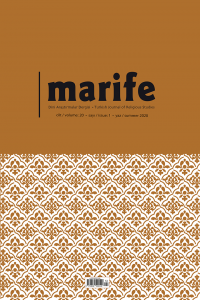Abstract
Bu çalışmada Kur’an ve Sünnet tarafından yasaklanmış olan riba işlemi, konuyla ilgili ayetlerin nazil olduğu dönemin tarihsel bağlamı üzerinden yorumlanmaktadır. Nitekim söz konusu işlemin tarihsel bağlamından kopuk bir şekilde veya doğrudan sözlük anlamı üzerinden anlaşılması sadece vahim bir hataya sebep olmakla kalmamakta, aynı zamanda Kur’an ve Sünnet’in ruhunu ve maksadını da ıskalamamıza yol açmaktadır. Bu minvalde çalışmamız okuyucuyu önce Kur’an ve Sünnet’in en iyi şekilde anlaşılmasının daha muhtemel olduğu İslam’ın erken dönemlerine doğru bir yolculuğa çıkarmakta ve oradan buraya doğru gelirken riba yasağının ilk beş asır içerisinde nasıl özgün ve saygın konumundan uzaklaştırılarak bambaşka bir boyuta evrildiğini anlatmaktadır.
Çalışmamızın konuyu her yönüyle tükettiği elbette söylenemez. Lakin barika-i hakikat müsademe-i efkârdan doğar düsturunca bilimsel gelişmenin fikirlerin tartışılmasıyla gerçekleştiği de inkâr edilemez. Bu açıdan ister tasvip ister eleştiri kabilinden olsun, bu çalışmanın İslam İktisadı alanında hak ettiği ilgiyi görmesini temenni ederiz.
Keywords
References
- Ahmed bin Hanbel, “Müsned”, Kahire, h.1313.
- Ali bin Ahmed el-Azîzî, “Sirâcü’l-Münîr”, Kahire, h.1257.
- Ali el-Muttakî el-Hindî, “Kenzü’l-Ummâl”, Haydarabad, h.1312.
- Bedreddin el-Aynî, “Umdetü’l-Kârî”, İstanbul, h.1310.
- Cemaat-i İslamî, No. 20, Lahor.
- Ebu Davud, “Sünen”.
- Darimî, “Sünen”.
- Edward Gibbon, “History of the Decline and Fall of the Roman Empire”.
- Beyhakî, “Es-Sünenü’l-Kübra”, Haydarabad, h.1352.
- Beyzavî, “Tefsir”, İstanbul, h.1316.
- Buharî, “Sahih”.
- Cessâs, “Ahkâmü’l-Kur’ân”, İstanbul, h.1335.
- Mevdûdî, “Sûd”, Lahor, 1954, 1961.
- Nesâi, “Sünen”.
- Suyûtî, “Dürrü’l-Mensûr”, Tahran, h.1377.
- Suyûtî, “el-Câmiü’s-Sağîr”.
- Suyûtî, “el-İtkân fî Ulûmi’l-Kur’ân”, Matbaa Musaviye, Kahire, h.1278.
- Şafiî, “Risâle”, Kahire, h.1321.
- Taberî, “Tefsîr”, Kahire: Darü’l-Maarif, h.1374.
- Tirmizî, “el-Câmi”.
- Ziriklî, el-A’lâm, Kahire, 1926.
- İbni Hacer el-Askalânî, “Fethü’l-Bârî”, Kahire, h.1319
- İbni Kayyim el-Cevziyye, “İ’lâmü’l-Muvakkıîn”, Delhi, h.1313.
- İbni Mâce, “Sünen”.
- İbni Mansûr, “Lisânü’l-Arab”.
- İbnü’l-Arabî, “Ahkâm’ül-Kur’ân”, Kahire, 1957.
- İbnü’l-Esîr, “Nihâye”, Kahire, h.1322.
- Malik bin Enes, “Muvatta”.
- Muhammed Murtazâ ez-Zebîdî, “Tâcü’l-Arûs”.
- Müftü Muhammed Şafiî, “Mesele-i Sûd”, Karaçi, h.1380.
- Müslim, “Sahih”.
- Reşid Rıza, “Tefsirü’l-Menâr”, Kahire, h.1367.
Abstract
This study offers an interpretation of riba, a transaction forbidden by Quran and Sunnah, in light of the historical context in which the corresponding verses were revealed. For as long as this transaction is understood without considering its relevant context or through its literal meaning, it not only leads to a fatal mistake, but also causes to miss the spirit and objective of Qur’an and Sunnah. Thus, our study takes the reader to the early periods of Islam in which there is a higher chance of understanding Quran and Sunnah much better and then explains how the prohibition of riba evolved in time from its original and prestigious position to something totally different.
There is no doubt that this study is far from exhausting its topic, yet it is also undeniable that scientific development is realized by debating ideas as the famous Turkish proverb goes: the light of truth rises through the collusion of ideas. So, whether it be on the purpose of approval or on the purpose of objection, we wish that this study will receive the attention it deserves in the field of Islamic Economics.
Keywords
Supporting Institution
Islamic Research Institute (IRI), International Islamic University, Islamabad, Pakistan.
Thanks
Islamic Research Institute (IRI), International Islamic University, Islamabad, Pakistan.
References
- Ahmed bin Hanbel, “Müsned”, Kahire, h.1313.
- Ali bin Ahmed el-Azîzî, “Sirâcü’l-Münîr”, Kahire, h.1257.
- Ali el-Muttakî el-Hindî, “Kenzü’l-Ummâl”, Haydarabad, h.1312.
- Bedreddin el-Aynî, “Umdetü’l-Kârî”, İstanbul, h.1310.
- Cemaat-i İslamî, No. 20, Lahor.
- Ebu Davud, “Sünen”.
- Darimî, “Sünen”.
- Edward Gibbon, “History of the Decline and Fall of the Roman Empire”.
- Beyhakî, “Es-Sünenü’l-Kübra”, Haydarabad, h.1352.
- Beyzavî, “Tefsir”, İstanbul, h.1316.
- Buharî, “Sahih”.
- Cessâs, “Ahkâmü’l-Kur’ân”, İstanbul, h.1335.
- Mevdûdî, “Sûd”, Lahor, 1954, 1961.
- Nesâi, “Sünen”.
- Suyûtî, “Dürrü’l-Mensûr”, Tahran, h.1377.
- Suyûtî, “el-Câmiü’s-Sağîr”.
- Suyûtî, “el-İtkân fî Ulûmi’l-Kur’ân”, Matbaa Musaviye, Kahire, h.1278.
- Şafiî, “Risâle”, Kahire, h.1321.
- Taberî, “Tefsîr”, Kahire: Darü’l-Maarif, h.1374.
- Tirmizî, “el-Câmi”.
- Ziriklî, el-A’lâm, Kahire, 1926.
- İbni Hacer el-Askalânî, “Fethü’l-Bârî”, Kahire, h.1319
- İbni Kayyim el-Cevziyye, “İ’lâmü’l-Muvakkıîn”, Delhi, h.1313.
- İbni Mâce, “Sünen”.
- İbni Mansûr, “Lisânü’l-Arab”.
- İbnü’l-Arabî, “Ahkâm’ül-Kur’ân”, Kahire, 1957.
- İbnü’l-Esîr, “Nihâye”, Kahire, h.1322.
- Malik bin Enes, “Muvatta”.
- Muhammed Murtazâ ez-Zebîdî, “Tâcü’l-Arûs”.
- Müftü Muhammed Şafiî, “Mesele-i Sûd”, Karaçi, h.1380.
- Müslim, “Sahih”.
- Reşid Rıza, “Tefsirü’l-Menâr”, Kahire, h.1367.
Details
| Primary Language | Turkish |
|---|---|
| Subjects | Religious Studies |
| Journal Section | Translation |
| Authors | |
| Translators | |
| Publication Date | June 30, 2020 |
| Acceptance Date | June 24, 2020 |
| Published in Issue | Year 2020 Volume: 20 Issue: 1 |
Cited By
İdarî İşlemin Geri Alınmasında, İçtihadı Birleştirme Kurulu Kararlarının İdarî Yargı Pratiğindeki Uygulanışına Dair Bir Değerlendirme
Selcuk Universitesi Hukuk Fakultesi Dergisi
https://doi.org/10.15337/suhfd.869652
NOMİNAL-REEL FAİZ AYRIMI ÇERÇEVESİNDE İSLÂM'DA FAİZ YASAĞININ KAPSAMINI YENİDEN DÜŞÜNMEK
Kafkas Üniversitesi İlahiyat Fakültesi Dergisi
https://doi.org/10.17050/kafkasilahiyat.1115438
Birlikte Yaşama Kültürünün Kur’ânî Temelleri (İsra Suresi 23-29 Ayetleri Özelinde)
Marife Dini Araştırmalar Dergisi
https://doi.org/10.33420/marife.1521038
This work is licensed under a Creative Commons Attribution-NonCommercial 4.0 International License.

